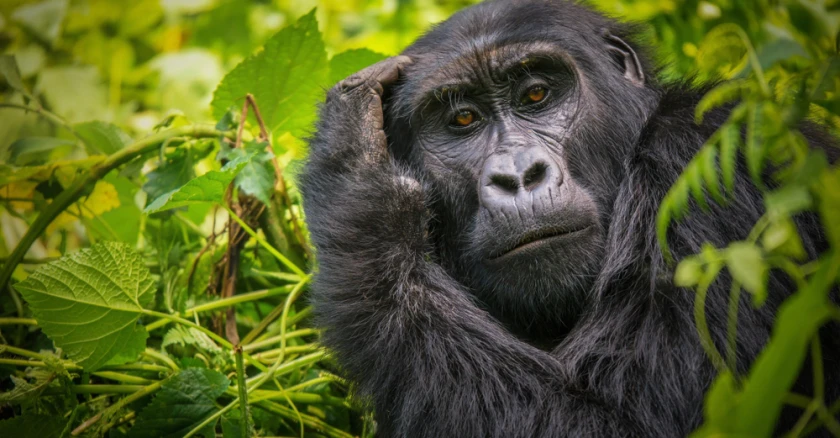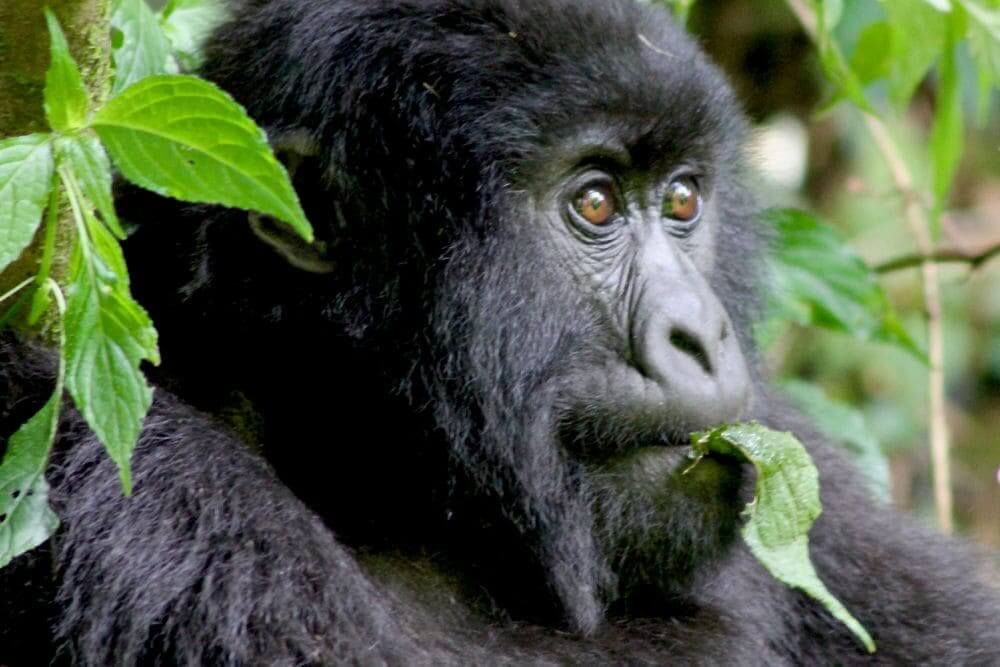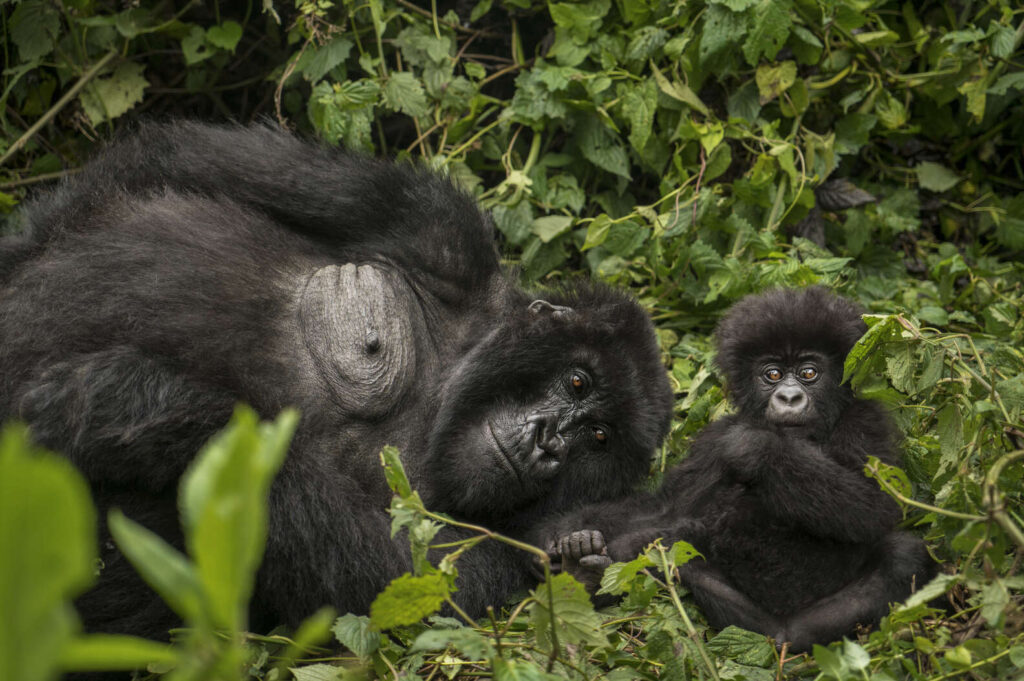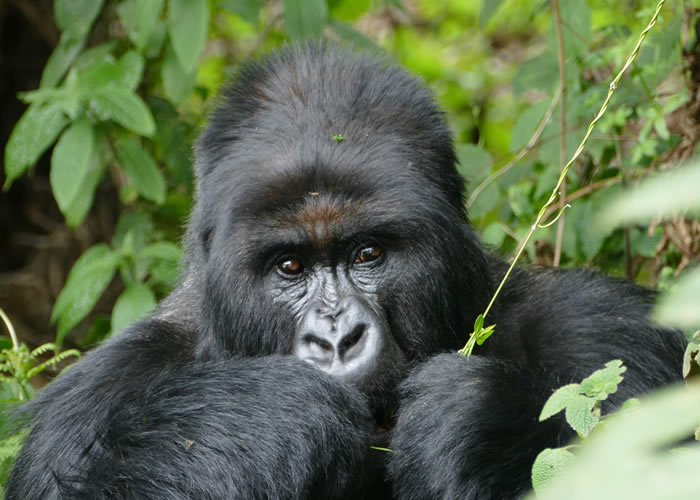Amazing facts about Mountain Gorillas in Rwanda, Uganda & Congo with Primate Safaris.
Gorillas are one of the most fascinating and endangered species on Earth, Uganda and Rwanda offer some of the best opportunities in the world to see them in the wild. Both countries are home to the rare and majestic mountain gorillas, which inhabit the dense forests and volcanic slopes of the Virunga Mountains and Bwindi Impenetrable National Park. These incredible creatures, known for their strong family bonds and complex social behaviors, have been the focus of significant conservation efforts that have led to their population increase in recent years.
Uganda and Rwanda’s commitment to protecting these endangered primates has not only helped conserve gorilla populations but has also transformed local communities by providing jobs and generating income through Eco-tourism. In addition to their conservation success, both countries offer unique experiences for trekkers, each with its own set of advantages.
Uganda is home to the largest number of mountain gorillas and offers a more adventurous, rugged trekking experience, while Rwanda’s shorter treks and stunning landscapes offer a more comfortable way to observe these magnificent animals. Whether in the misty jungles of Bwindi or the volcanic slopes of Volcanoes National Park, the opportunity to witness gorillas in their natural habitat is one of the most incredible wildlife experiences you can have.
-
The Mountain Gorilla: A Rare Species
 Mountain gorillas (Gorilla beringei beringei) are a subspecies of the eastern gorilla and are found only in two regions in the world: the Virunga Mountains, which straddle the borders of Uganda, Rwanda, and the Democratic Republic of Congo (DRC), and Bwindi Impenetrable National Park in Uganda. These gorillas live in high-altitude forests, where they are adapted to cooler temperatures and dense vegetation.
Mountain gorillas (Gorilla beringei beringei) are a subspecies of the eastern gorilla and are found only in two regions in the world: the Virunga Mountains, which straddle the borders of Uganda, Rwanda, and the Democratic Republic of Congo (DRC), and Bwindi Impenetrable National Park in Uganda. These gorillas live in high-altitude forests, where they are adapted to cooler temperatures and dense vegetation.
Mountain gorillas are distinct from lowland gorillas, which live in forests at lower altitudes in countries like Gabon and Cameroon. Mountain gorillas are slightly smaller, but they are still incredibly strong, with adult males (known as silverbacks) reaching up to 6 feet tall and weighing between 300 and 485 pounds. Female gorillas are smaller and more nimble, but they are still strong, with some reaching up to 4.5 feet in height and weighing around 150 pounds.
The population of mountain gorillas has been steadily increasing in recent decades due to successful conservation efforts, but they are still classified as endangered by the International Union for Conservation of Nature (IUCN), with fewer than 1,000 individuals left in the wild.
-
The Role of Uganda and Rwanda in Gorilla Conservation
 Both Uganda and Rwanda play critical roles in the protection of mountain gorillas. Uganda is home to Bwindi Impenetrable National Park, which has the largest population of mountain gorillas, while Rwanda’s Volcanoes National Park is home to several gorilla families as well. Conservation efforts in both countries began in the mid-20th century when the mountain gorilla population was dwindling due to poaching, habitat destruction, and disease. Since then, both Uganda and Rwanda have worked together with international organizations, like the International Gorilla Conservation Programme (IGCP), to protect these incredible animals.
Both Uganda and Rwanda play critical roles in the protection of mountain gorillas. Uganda is home to Bwindi Impenetrable National Park, which has the largest population of mountain gorillas, while Rwanda’s Volcanoes National Park is home to several gorilla families as well. Conservation efforts in both countries began in the mid-20th century when the mountain gorilla population was dwindling due to poaching, habitat destruction, and disease. Since then, both Uganda and Rwanda have worked together with international organizations, like the International Gorilla Conservation Programme (IGCP), to protect these incredible animals.
One of the major success stories in mountain gorilla conservation is the introduction of gorilla tourism, where people can visit these parks and trek to see the gorillas in the wild. The funds generated from tourism are used to support conservation projects, local communities, and anti-poaching efforts. Gorilla trekking has become a vital source of income for both countries, providing jobs and improving infrastructure in the regions where the gorillas live. The gorilla population in Uganda and Rwanda has been slowly increasing due to these conservation efforts. In fact, the number of mountain gorillas in the wild has risen from an estimated 650 individuals in the early 2000s to over 1,000 today.
-
Gorilla Families and Social Structure
 Gorillas are social animals that live in groups called troops or families. These families are led by a dominant male, known as a silverback, who is responsible for the safety and well-being of the group. The silverback gets his name from the silver-colored hair that grows on his back as he ages. He is the protector of the family and makes important decisions, such as where the group will sleep and when they will move. In addition to the silverback, a gorilla family usually includes several adult females, their young offspring, and sometimes younger males (called blackbacks) who are not yet mature enough to take on the role of a silverback. The silverback is the only male who mates with the females, ensuring that the offspring are his. The females in the family share strong bonds and care for their young together, often helping each other with child-rearing.
Gorillas are social animals that live in groups called troops or families. These families are led by a dominant male, known as a silverback, who is responsible for the safety and well-being of the group. The silverback gets his name from the silver-colored hair that grows on his back as he ages. He is the protector of the family and makes important decisions, such as where the group will sleep and when they will move. In addition to the silverback, a gorilla family usually includes several adult females, their young offspring, and sometimes younger males (called blackbacks) who are not yet mature enough to take on the role of a silverback. The silverback is the only male who mates with the females, ensuring that the offspring are his. The females in the family share strong bonds and care for their young together, often helping each other with child-rearing.
A typical gorilla family in Uganda and Rwanda consists of between 5 to 20 individuals, although some larger families can have up to 30 members. These families are often spread out over a large area of the forest as they search for food, but they stay close to each other for protection and companionship. Gorilla families in both Uganda and Rwanda are habituated to human presence, meaning they are used to seeing tourists. This is done gradually by conservationists and researchers who spend time with the gorillas in a controlled way. As a result, trekkers are allowed to visit the gorillas for one hour each day, during which they can observe the family’s behaviour and interactions.
- Gorilla Behaviour and Communication
 Gorillas are intelligent, gentle, and highly social animals. Despite their large size and strength, they are known for their peaceful behaviour and strong family bonds. They spend their days foraging for food, grooming each other, and playing. Gorillas communicate in many ways, including through vocalizations, body language, and facial expressions. They use grunts, roars, and hoots to communicate with each other over long distances. When they are happy or content, gorillas may make a soft humming sound. They also communicate their emotions through body posture and gestures. For example, a silverback may stand tall and beat his chest to assert dominance or to warn other animals to stay away.
Gorillas are intelligent, gentle, and highly social animals. Despite their large size and strength, they are known for their peaceful behaviour and strong family bonds. They spend their days foraging for food, grooming each other, and playing. Gorillas communicate in many ways, including through vocalizations, body language, and facial expressions. They use grunts, roars, and hoots to communicate with each other over long distances. When they are happy or content, gorillas may make a soft humming sound. They also communicate their emotions through body posture and gestures. For example, a silverback may stand tall and beat his chest to assert dominance or to warn other animals to stay away.
Gorillas also express emotions like joy, sadness, and affection. Young gorillas often engage in playful activities, such as chasing each other, rolling on the ground, or swinging from tree branches. Mothers and their babies share a very close bond, with mothers grooming and hugging their young. In fact, the relationship between a mother and her infant is one of the most endearing aspects of gorilla behavior.
-
Diet and Eating Habits
Gorillas are herbivores, meaning they mainly eat plants. Their diet consists of a variety of vegetation, including leaves, stems, fruits, flowers, and bamboo shoots. They have strong jaws and teeth that are perfectly suited for chewing tough plant material. In the wild, gorillas spend up to 12 hours a day foraging for food, and they need to consume a large amount of vegetation to sustain their energy. Mountain gorillas, in particular, tend to eat more leaves and stems than other gorilla species because of the higher altitude and the availability of vegetation in their environment. While their diet is largely vegetarian, gorillas may occasionally eat insects, such as termites or ants, for extra protein.
The availability of food in their habitat plays a big role in the size and health of a gorilla family. In Uganda and Rwanda, the forests are rich in plant life, which provides the gorillas with a balanced diet. As part of conservation efforts, park rangers monitor the health of the gorillas and their food sources to ensure they have enough to eat and can continue to thrive in their habitats.
-
Gorilla Trekking in Uganda and Rwanda
Gorilla trekking in Uganda and Rwanda is one of the most popular and unforgettable wildlife experiences in the world. Visitors to both countries can take guided treks through the forests to see mountain gorillas up close. The experience of trekking through the jungle and encountering a gorilla family is awe-inspiring, and it is one of the highlights of any trip to East Africa.
- Uganda offers trekking opportunities in Bwindi Impenetrable National Park and Mgahinga Gorilla National Park, both of which are known for their dense forests and more challenging trekking conditions. The treks in Uganda can be longer and more strenuous, as the gorillas are sometimes found in hard-to-reach areas. However, this makes the experience feel more adventurous and rewarding.
- Rwanda offers trekking in Volcanoes National Park, which is known for its stunning volcanic landscapes and shorter treks. The gorillas in Rwanda are often found at lower altitudes, which makes the treks easier and less physically demanding. The park is well-maintained, and the infrastructure around the trekking experience is highly developed, making it a great option for those who prefer a more comfortable experience.
In both countries, only a limited number of permits are available each day to reduce the impact of tourism on the gorillas. This ensures that the gorillas are not disturbed and that the experience remains special for all those who visit.
Conclusion
Gorillas are extraordinary creatures that play a crucial role in the ecosystems of Uganda and Rwanda. Both countries offer incredible opportunities to see these magnificent animals up close through responsible and sustainable tourism. The success of conservation efforts in both countries has led to an increase in the mountain gorilla population, but there is still much work to be done to ensure their long-term survival. By visiting Uganda or Rwanda for gorilla trekking, travelers can not only witness these remarkable animals but also contribute to their protection and the preservation of their natural habitats for generations to come.


